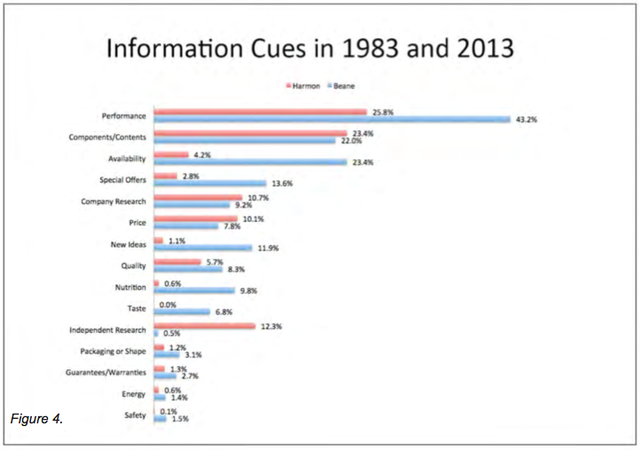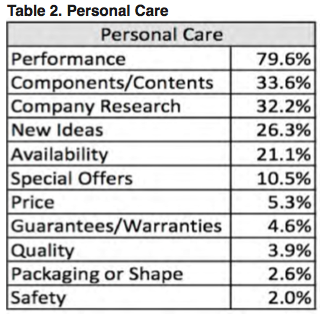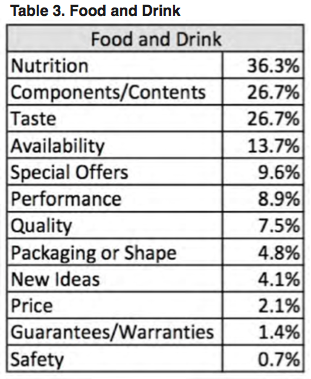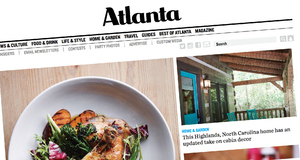From Elon Journal of Undergraduate Research in Communications VOL. 4 NO. 2Appealing to Women: An Analysis of Print Advertisements in Three Women's Interest MagazinesInformation Cues - Overall Information CuesRQ4 asked about informational cues advertisers most frequently use to appeal to women. The frequency of the information cues is illustrated in Figure 4. Almost half or 43.2% of the advertisements mentioned performance. This means that 43.2% of the advertisements answered the question, "What does theroduct do?" or "How well does it perform relative to other products?" The second most used cue was Availability, which answered the question, "Where can the product be purchased?" or "When will the product be available for purchase?" 23.4% of the advertisements used this cue? The third most used appeal was Components/Contents, which answered the question, "What is the product composed of?" or "What ingredients does it contain?" or "What ancillary items are included with the product?"Special Offers were also used frequently (13.6%). This appeal answered the question, "What limitedtime deals are available with a particular purchase?" New Ideas (11.9%) dealt with the advertisements that introduced a totally new concept or presented the advantages of the new concept.
Information Cues – A 30-Year SpanRelatively speaking, many of the appeals that were used in 1983 and 2013 were similar in terms of percentages. The following areas showed the difference of 5% or more during the 30-year period, as shownn Figure 4. Performance was up 17.4%; nutrition up 9.2%, which dovetails with the increased amount of advertisements in 2013, 5.1% more than 30 years ago; and taste up 6.8% from nil in 1983. Independent research went down from 12.3% in 1983 to .5% in 2013. It seems that if any research was used, it was company research. The following areas showed less than 5% of changes over the time probably because those appeals are as equally valued and used today as they were 30 years ago. These categories included Components/ Contents; Company Research; Price; Quality; Packaging or Shape; Guarantees/Warranties; Energy; Safety. The last two categories were not expected, given today's society value of "green" products and safety features. Special Offers can't be compared because the researchers in the 1983 study only included "limitedtime, non-price deals" but the author looked at all deals, including price deals. Information Cues: Comparing Product CategoriesRQ5 asked what informational cues do advertisers use most frequently within different product categories? The product categories most frequently used were personal care, food and drink, and laundry and household products. Personal CareThe three cues most frequently found in advertisements for products that were in the "personal care" category were performance, components/contents, and company research, as shown in Table 2. Advertisers most frequently explain what the personal care product does or how well it performs relative to other products, as well as explaining what the products is composed of or what ingredients it contains. Advertisers frequently use these cues to compare their products with their competitor. Additionally, advertisers may use research to back up the statements about how the product performs relative to others' products. Food and DrinkThe three cues most frequently used for "food and drink" products were nutrition, components/contents, and taste, as shown in Table 3 above. Researchers most frequently give specific data concerning the nutritional value of a product or make a direct specific comparison with another product, as well as explaining what the product is composed of or what it contains. Additionally, they frequently present evidence from an independent source that the taste of their product is superior to others.'
Laundry and Household ProductsThe three cues most frequently used for products that fell into the "laundry and household products" categoryere performance, availability, and components/contents, as shown in Table 4 on next page. Advertisers most frequently explain what their laundry or household product does and/or how well it performs relative to others'. Additionally, advertisers often state when and where the product can be purchased. It is also common for advertisers to mention what the laundry or household product is composed of, what it contains, or what supplemental items are included with the product.Continued on Next Page » Suggested Reading from Inquiries Journal
Inquiries Journal provides undergraduate and graduate students around the world a platform for the wide dissemination of academic work over a range of core disciplines. Representing the work of students from hundreds of institutions around the globe, Inquiries Journal's large database of academic articles is completely free. Learn more | Blog | Submit Latest in Business & Communications |






















